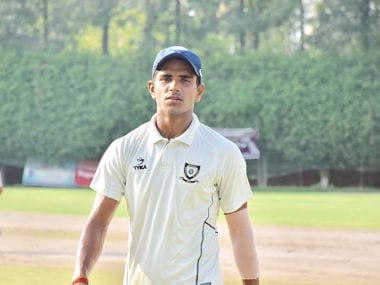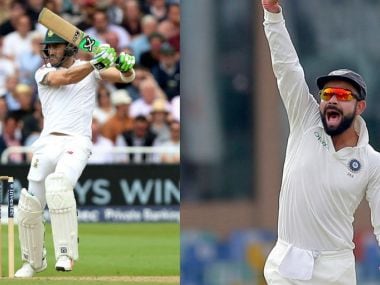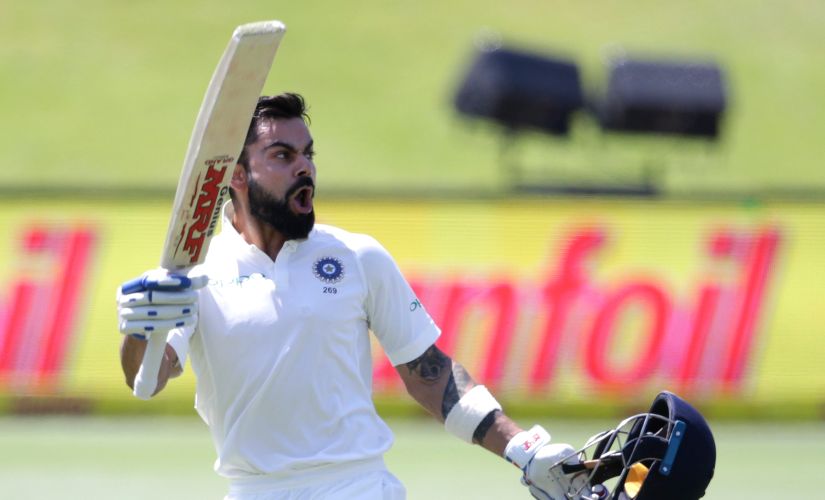ICC U-19 World Cup 2018: On a knee and strong shoulders, Shivam Mavi's comeback from injury is inspirational
India's latest U-19 pace sensation overcame an ACL tear on his landing foot and developed the inswinger to emerge a more complete and lethal bowler.
Snehal Pradhan, Jan,24 2018
- ICC Under-19 World Cup, 2018 PAK Vs SA Pakistan Under-19 beat South Africa Under-19 by 3 wickets
- ICC Under-19 World Cup, 2018 ENG Vs AUS Australia Under-19 beat England Under-19 by 31 runs
- ICC Under-19 World Cup, 2018 WI Vs IRE West Indies Under-19 beat Ireland Under-19 by 4 wickets
- ICC Under-19 World Cup, 2018 SL Vs KEN Sri Lanka Under-19 beat Kenya Under-19 by 311 runs
- ICC Under-19 World Cup, 2018 ZIM Vs NAM Zimbabwe Under-19 beat Namibia Under-19 by 7 wickets
| Rank | Team | Points | Rating |
|---|---|---|---|
| 1 | India | 4969 | 124 |
| 2 | South Africa | 3888 | 111 |
| 3 | Australia | 4174 | 104 |
| 4 | New Zealand | 3489 | 100 |
| 5 | England | 4829 | 99 |
| 6 | Sri Lanka | 4058 | 94 |
| Rank | Team | Points | Rating |
|---|---|---|---|
| 1 | South Africa | 6386 | 120 |
| 2 | India | 6680 | 119 |
| 3 | England | 6646 | 117 |
| 4 | New Zealand | 6550 | 115 |
| 5 | Australia | 6143 | 112 |
| 6 | Pakistan | 4875 | 96 |
| Rank | Team | Points | Rating |
|---|---|---|---|
| 1 | New Zealand | 2436 | 128 |
| 2 | Pakistan | 2919 | 122 |
| 3 | India | 3385 | 121 |
| 4 | England | 2029 | 119 |
| 5 | West Indies | 2538 | 115 |
| 6 | South Africa | 2238 | 112 |





Wikipedia defines a hinge joint as one which permits motion only in one plane. Your door works on hinge joints. So does your knee. But in very different ways.
Imagine moving your door in any other direction than swinging out or in. Up, down, diagonally. Twist it in the most contorted way. Imagine this repeatedly, with a force five times the weight of the door, thirty times a day, for years on end. Chances are your hinges will fall away within a week.
Shivam Mavi. Image courtesy Pankaj Mavi
Knees are stronger. Shivam Mavi’s left knee, his front foot knee, is strong. It bears forces of five times his body weight every time his body rolls over it. It twists, it shakes, and it contorts itself and then resets like a rubber band as he releases the ball at close to 140kmph, day in day out.
That same knee joint that, four years ago, struggled to support his weight.
When India won the toss and chose to field against Australia in the first group game, I mentally braced for impact. India’s top-heavy batting order would be exposed to Australian fast bowlers, who had first use of the wicket. But injuries to Australia’s top two bowlers and some sublime strokeplay meant that Prithvi Shaw and Manjot Kalra put on a 180-run opening stand.
Later in the day, India out-bowled the Aussies, not with their spinners, but their quicks. Kamlesh Nagarkoti was deadly, but over the next two games, proved a little inconsistent. More bankable, and nearly just as quick, was Shivam Mavi.
After his three wickets against Australia, Mavi also impressed against Papua New Guinea and Zimbabwe. Meaning no disrespect, but against the latter two it’s hard to judge one’s bowling by how the batsmen play; what the ball does before it reaches them is the more reliable measure. Barring a few unnecessarily short deliveries against PNG, Mavi started the ball around the sixth stump, and it dipped in as he drew the batters onto the front foot, threatening their pads, stumps and inner edge. One of the pleasures of being an inswinger is that it affords you more wicket-taking areas than outswing. But when Mavi started out, he was not an inswinger at all. Heck, he was not even a bowler.
“I used to stay in a village named Seena near Meerut. My parents brought me to Noida to for the sake of studies. There, I played gully cricket, mostly as a batsman”, Mavi told Firstpost. When his talent became apparent, he enrolled in the Delhi Wanderer’s cricket academy, under Phoolchand Sharma. When his coach saw him bowl, Mavi’s future as a bowling all-rounder was set in stone.
But it was outswing that Mavi bowled back then. The inswing was born as a result of the knee injury that Mavi suffered at the age of 15. “I was at a Zonal Cricket Academy camp in Kanpur. We were doing sliding on a plastic cover, and my leg got caught in the cover and I got injured.”
Mavi suffered a Grade Two tear to his Antertior Cruciate Ligament (ACL). A knee injury can cripple a fast bowler mentally more than physically. The fear of giving it everything creeps in, especially in the early days of rehab, where the knee tends to buckle. In this phase, Mavi benefited from the experience of training with senior fast bowlers who were already playing first-class cricket, particularly Railways and Kings XI Punjab’s Anureet Singh.
“Anureet Singh comes to the same academy as me. He really supported me, as he too had an ACL injury. So he kept telling me, mind se doubt nikalo, bas ball dalo (put the doubt out of your mind and just bowl)," Mavi says.
Mavi chose not to opt for surgery, and made his way back to cricket relying only on physiotherapy. While this is not unusual for Grade Two tears, what happened next is. “After that when I started bowling again, my body used to fall over (in the bowling action). Slowly I started to get control, but then my wrist position became inswing. So then I started working on that only, and it has improved.” Mavi says he lost a couple of yards of pace after the injury, but gained swing. “Earlier I did not swing the ball much. Now I get swing, and I’m trying to generate pace.”
He’s obviously on the right track, pace and swing wise. Mavi was second quickest against Australia, averaging 141.2 kph, with a fastest ball of 144.5. In the words of the Australian batters, the pace on offer was “a little bit of a surprise”. Not so for Indian bowling coach Paras Mhambrey, a former international medium-pacer himself.
“Now there is a structure in place back home. These guys are going through a lot of camps from the Under-16 age group, and being monitored. Now at the Under-19 level, you see it actually taking shape a little bit”, Mhambrey told the ICC website.
“These guys are a lot fitter than what we were. I see Under-19 kids work very hard, they are much stronger, more aware of what is their requirement and how to get it. Also the kind of support staff we have; the trainer is working hard.” Anureet as well, in an earlier interview with Firstpost, described Mavi’s biggest strength as his fitness. “But it’s not only the physique, it’s also the mental setup. They want to bowl quick”, Mhambrey adds.
With India being tagged as favourites in the business end of the tournament, there will be more pressure on the fast bowlers, having been talked up so much in the group stages. But Mavi has shown the temperament, technique and fitness to shoulder that. Propping up those shoulders, are his strong knees.
Published Date:Jan 24, 2018
| Updated Date: Jan 24, 2018
Also See
ICC U-19 World Cup 2018: India look to secure knockout berth in clash against minnows Papua New Guinea
ICC U-19 World Cup 2018: Manjot Kalra's maiden fifty shows his class and steely resolve
ICC U-19 World Cup 2018: India trounce Australia by 100 runs to make winning start to tournament